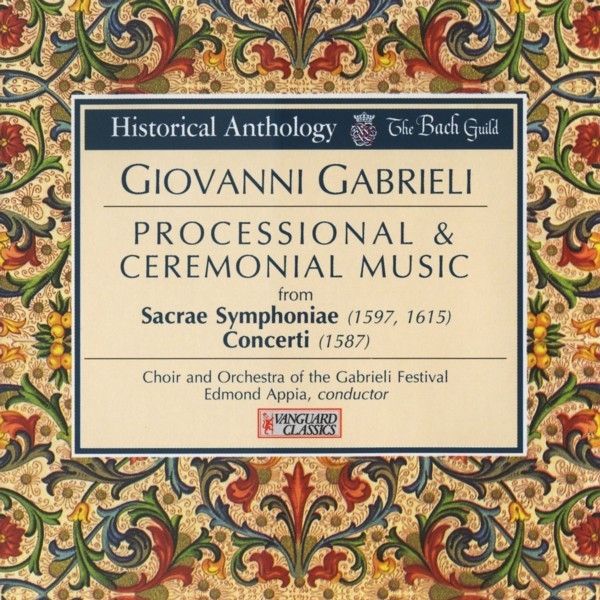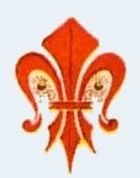
The Bach Guild · Historical Antology
Vanguard Classics 08 2007 71
1958 / 1993

The Bach Guild · Historical Antology
Vanguard Classics 08 2007 71
1958 / 1993
1. Sancta et
immaculata virginitas [3:13]
Sacrae Symphoniae, 1597
8-part Double Chorus, with 4 recorders, 2 oboes, 2 clarinets,
bassoon,
3 trombones, double bass, 2 organs (positive and regal)
2. O magnum
mysterium [3:29]
Concerti, 1587
8-part Double Chorus, with oboe, 3 clarinets, 3 trombones, lute,
viola,
double bass, 3 organs (2 positives, regal)
3. Nunc dimittis
[3:58]
Sacrae Symphoniae, 1597
14-part Triple Chorus, with 3 recorders, oboe, English horn, 3
clarinets,
3 bassoons, contra-bassoon, French horn, trumpet, 3 trombones, viola,
double bass, 4 organs (3 positives regal)
4. Angelus ad
pastores [2:59]
Concerti, 1587
12-part Double Chorus, with 3 recorders, 3 clarinets, 3 bassoons, 3
trombones,
violin, viola, bass-gamba, double bass, 3 organs (2 positives, regal)
5. O Jesu mi
dulcissime [7:20]
Sacrae Symphoniae, 1615 (For Christmas)
8-part Double Chorus, with 3 recorders, oboe, clarinet, 3 bassoons,
2 trombones,
lute, viola, diskant-gamba, bass-gamba, double bass, 3 organs (2
positives, regal)
6. Exaudi Deus
[3:32]
Sacrae Symphoniae, 1597
7-part Chorus, with 2 clarinets, 3 bassoons, 3 trombones, organ
(regal)
7. Hodie completi
sunt [5:24]
Sacrae Symphoniae, 1615 (For Pentecost)
8-part Double Chorus, with 2 bassoons, 2 organs (positive)
8. O Domine Jesu
Christe [5:46]
Sacrae Symphoniae, 1597 (Passion Motet)
8-part Double Chorus, with 2 organs (positive and regal)
9 - Canzona quarti
toni a 15 [4:08]
(Ricercar) · Sacrae Symphoniae, 1597
15-part Ricercar, 3 instrumental choirs; 3 recorders, 2 oboes,
English horn, 2 clarinets, bass clarinet,
3 bassoons, contra-bassoon, horn, viola, diskant-gamba, bass-gamba, 3
organs (positive)
10. Inclina Domine
[3:34]
Concerti, 1587
6-part Chorus, with 3 recorders, bassoon, viola, bass-gamba
Choir and Orchestra of the Gabrieli Festival · Hans
Gillesberger, choir director
Anton Heiner, Franz Eibner, Herbert Tachezi, Rene Clemencic, organists
Edmond Appia, conductor
Musicological Advisor: Martin Bernstein,
Prof. Emeritus of Music, New York University
Sources: Giovanni Gabrieli, Opera Omnia, Vol. I, 1956.; Vol II, 1959;
III, 1962; ed. Denis Arnold (sec. source)
Editions: Prepared by Prof. Anton Heiller and Prof. Josef Mertin of the
Vienna Academy of Music
Recorded February, 1958. columbia Studio, Vienna
originally released as BGS 5004
Producer: Karl Wolleitner
Engineer Franz Plott
Digital Remastering: David Baker
1958 © 1993 VANGUARD CLASSICS

NOTES ON THE PROGRAM
"...Gabrieli, immortal gods, how great a man! If loquacious
antiquity had seen him, let me say it in a word, it would have set him
above Amphions, or if the Muses loved wed-lock, Melpomene would have
rejoiced in no other spouse..."
—Heinrich Schütz
Visitors to Venice in the early years of the 17th century encountered a
music of a grandeur and an order of excellence unsurpassed in their
experience. A French visitor, Jean-Baptiste du Val, was as much
fascinated by the diversity of musical forces involved in a performance
(winds, strings and organs in addition to the voices) as he was
astonished by the massive harmony produced by their combination. And an
English visitor, Thomas Coryat, even more impressionable, reported of
the music "both vocall and instrumental" that it was "so good, so
delectable, so rare, so admirable, so super-excellent, that it did even
ravish and stupifie all those strangers that never heard the like."
From Coryat we learn of the variety in the size of the musical
ensembles, the diversity of the instruments employed therein, and
something of the quality of the individual performers.
"Sometimes there sung sixeteene or twenty men together, having their
master or moderator to keepe them in order; and when they sung, the
instrumental musitians played also. Sometimes sixeteene played together
upon their instruments, ten Sagbuts, foure Cornets, and two
Violdegambaes of an extra-ordinary greatness; sometimes tenne, sixe
Sagbuts and foure Cornets; sometimes two, a Cornet and a treble violl.
Of those treble viols I heard three severall there, whereof each was so
good, especially one that I observed above the rest, that I never heard
the like before. Those that played upon the treble viols, sung and
played together, and sometimes two singular fellowes played together
upon Theorboes, to which they sung also, who yeelded admirable sweet
musicke, but so still that they could scarce be heard but by those that
were very neare them. These two Theorbists concluded that nights
musicke, which continued three whole howers at the least. For they
beganne about five of the clocke, and ended not before eight. Also it
continued as long in the morning: at every time that every severall
musicke played, the Organs, whereof there are seven faire paire in that
room, standing al in a rowe together, plaied with them. Of the singers
there were three or foure so excellent, that I thinke few or none in
Christendome do excel! them...."
Venice was a city of exuberant splendor, and the music that held
visitors spellbound was an essential ingredient not only in the lavish
secular entertainments, but also in the sumptuous religious
celebrations that were so notable a part of the life of the city.
Characteristically, du Val's impressions were gained from a vespers
service at the Church of the Holy Savior before the feast of Saint
Theodore, while Coryat's (quoted above) were based on a "festivitie...
solemnized to the honour of Saint Roch," which feast, he tells us,
"consisted principally of Musicke...." For the Venetian, the border
that separated the religious from the secular seems frequently to have
been blurred. In Venetian painting, one need only recall Bellini's Procession
in Saint Mark's Square, or Veronese's Marriage at Cana or
his Feast at the House of Levi, to realize the infusion of
secular pomp in the religious pageantry of the Venetians. As organist
at St. Mark's, Giovanni Gabrieli was a member of the Ducal Chapel. And
as Denis Arnold observes: "The musicians of St. Mark's are best seen
not as servants of the church, but rather as being part of one of the
most brilliant courts of Europe." The work of Gabrieli is in large
measure of a ceremonial character. "His motets," remarks Arnold (whose
edition of the first volume of the Opera Omnia is the source
for six of the motets presented here), "are nearly all settings of
parts of the liturgy used on the great Venetian
festivals—Christmas, Easter, the Ascension and St. Mark's Day."
As for some of Gabrieli's other double choir music, Arnold conjectures
that they were "perhaps written for the entertainments so popular
during the term of office of the Doge Marino Grimani, played several
times a year in the Palazzo Ducale."
While St. Mark's was not the only place where music for multiple choirs
flourished, as a church whose galleries overlooked a vast interior
space, it was singularly adapted to an impressive spatial arrangement
of multiple choirs. The spatial component seems an especially important
part of the aesthetics of Gabrieli's polychoral practice, and the
architecture of the church where he served as organist may well have
provided a source for suggestion and a testing ground for experiment.
Likewise, while the techniques of divided choir treatment neither
originated nor ended with Gabrieli, his imagination in the exploitation
of these techniques makes his work a veritable compendium of the
polychoral style. More impressive than the techniques per se is
the wide range of expressive purpose to which they are put. The surface
of Gabrieli's music reflects, to be sure, its once functional role as
part of the pageantry of Venetian church ceremonial. But what survives
in a modern resuscitation of his music is not merely an impressive
relic of a curiously grandiloquent culture. "The grandiloquent man,"
remarked George Eliot, "is never bent on saying what he feels or what
he sees, but on producing a certain effect on his audience."
Impressing—indeed overpowering—an audience was by all means
relevant to Gabrieli's purposes, but the ceremonial strut, the pompous
processional manner, is much ameliorated by moments of tender lyricism,
and by a passion as urgent as it is inward. The splendor of the Nunc
dimittis must be balanced against the gentle purity of the Angelus
ad Pastores and the inwardness of the O Jesu mi dulcissıme.
This balance in the range of expression characterizes not only the
music of Gabrieli, but also the work of the greatest of his pupils,
Heinrich Schütz, whose tribute to the master serves as
introduction to these notes.
—Notes by Abraham Veinus,
Syracuse University

ABOUT THE PERFORMANCE
The Intonazioni, or Preludes for solo organ, performed here by
Anton Heiller, are played before each of the motets in accordance with
historical usage and with the liturgical tonal relations. Although the
Gabrieli motets were designed to be performed with instruments
supporting the vocal lines, the original manuscripts contain only the
vocal parts. Thus each motet required a special study to determine the
proper instrumentation according to 16th-century practice at St. Mark's
in Venice. The instrumentation for these performances was set by
Professor Mertin of the Vienna Academy of Music, who, in addition to
being an outstanding world authority on the music of this era, is one
of the foremost organ builders. The full instrumental body consists of
4 recorders (flute-à-bec), 2 oboes, English horn, 3 clarinets,
bass clarinet, 3 bassoons, contra-bassoon, French horn, trumpet, 3
trombones, lute, violin, viola, double bass, diskant-gamba,
bass-gamba, and 4 organs, including one regal (a small, portable
organ with reed-pipes only) and 3 positives, or "bureau" organs. Of the
latter, one dates from 1718; another is a reproduction of a 1510
instrument, and a third is a reproduction of the organ of the Silberne
Kapelle in Innsbruck. Modern wind instruments were used only when
necessary, to take the parts of the Renaissance Zinken (cornetts,
made of wood and leather), which proved unfeasible for use because of
pitch difficulties.
